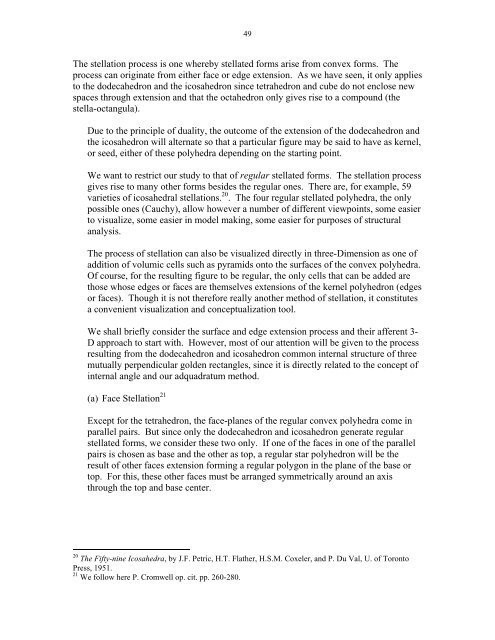Ad Quadratum Construction and Study of the Regular Polyhedra
Ad Quadratum Construction and Study of the Regular Polyhedra
Ad Quadratum Construction and Study of the Regular Polyhedra
You also want an ePaper? Increase the reach of your titles
YUMPU automatically turns print PDFs into web optimized ePapers that Google loves.
49<br />
The stellation process is one whereby stellated forms arise from convex forms. The<br />
process can originate from ei<strong>the</strong>r face or edge extension. As we have seen, it only applies<br />
to <strong>the</strong> dodecahedron <strong>and</strong> <strong>the</strong> icosahedron since tetrahedron <strong>and</strong> cube do not enclose new<br />
spaces through extension <strong>and</strong> that <strong>the</strong> octahedron only gives rise to a compound (<strong>the</strong><br />
stella-octangula).<br />
Due to <strong>the</strong> principle <strong>of</strong> duality, <strong>the</strong> outcome <strong>of</strong> <strong>the</strong> extension <strong>of</strong> <strong>the</strong> dodecahedron <strong>and</strong><br />
<strong>the</strong> icosahedron will alternate so that a particular figure may be said to have as kernel,<br />
or seed, ei<strong>the</strong>r <strong>of</strong> <strong>the</strong>se polyhedra depending on <strong>the</strong> starting point.<br />
We want to restrict our study to that <strong>of</strong> regular stellated forms. The stellation process<br />
gives rise to many o<strong>the</strong>r forms besides <strong>the</strong> regular ones. There are, for example, 59<br />
varieties <strong>of</strong> icosahedral stellations. 20 . The four regular stellated polyhedra, <strong>the</strong> only<br />
possible ones (Cauchy), allow however a number <strong>of</strong> different viewpoints, some easier<br />
to visualize, some easier in model making, some easier for purposes <strong>of</strong> structural<br />
analysis.<br />
The process <strong>of</strong> stellation can also be visualized directly in three-Dimension as one <strong>of</strong><br />
addition <strong>of</strong> volumic cells such as pyramids onto <strong>the</strong> surfaces <strong>of</strong> <strong>the</strong> convex polyhedra.<br />
Of course, for <strong>the</strong> resulting figure to be regular, <strong>the</strong> only cells that can be added are<br />
those whose edges or faces are <strong>the</strong>mselves extensions <strong>of</strong> <strong>the</strong> kernel polyhedron (edges<br />
or faces). Though it is not <strong>the</strong>refore really ano<strong>the</strong>r method <strong>of</strong> stellation, it constitutes<br />
a convenient visualization <strong>and</strong> conceptualization tool.<br />
We shall briefly consider <strong>the</strong> surface <strong>and</strong> edge extension process <strong>and</strong> <strong>the</strong>ir afferent 3-<br />
D approach to start with. However, most <strong>of</strong> our attention will be given to <strong>the</strong> process<br />
resulting from <strong>the</strong> dodecahedron <strong>and</strong> icosahedron common internal structure <strong>of</strong> three<br />
mutually perpendicular golden rectangles, since it is directly related to <strong>the</strong> concept <strong>of</strong><br />
internal angle <strong>and</strong> our adquadratum method.<br />
(a) Face Stellation 21<br />
Except for <strong>the</strong> tetrahedron, <strong>the</strong> face-planes <strong>of</strong> <strong>the</strong> regular convex polyhedra come in<br />
parallel pairs. But since only <strong>the</strong> dodecahedron <strong>and</strong> icosahedron generate regular<br />
stellated forms, we consider <strong>the</strong>se two only. If one <strong>of</strong> <strong>the</strong> faces in one <strong>of</strong> <strong>the</strong> parallel<br />
pairs is chosen as base <strong>and</strong> <strong>the</strong> o<strong>the</strong>r as top, a regular star polyhedron will be <strong>the</strong><br />
result <strong>of</strong> o<strong>the</strong>r faces extension forming a regular polygon in <strong>the</strong> plane <strong>of</strong> <strong>the</strong> base or<br />
top. For this, <strong>the</strong>se o<strong>the</strong>r faces must be arranged symmetrically around an axis<br />
through <strong>the</strong> top <strong>and</strong> base center.<br />
20<br />
The Fifty-nine Icosahedra, by J.F. Petric, H.T. Fla<strong>the</strong>r, H.S.M. Coxeler, <strong>and</strong> P. Du Val, U. <strong>of</strong> Toronto<br />
Press, 1951.<br />
21<br />
We follow here P. Cromwell op. cit. pp. 260-280.




